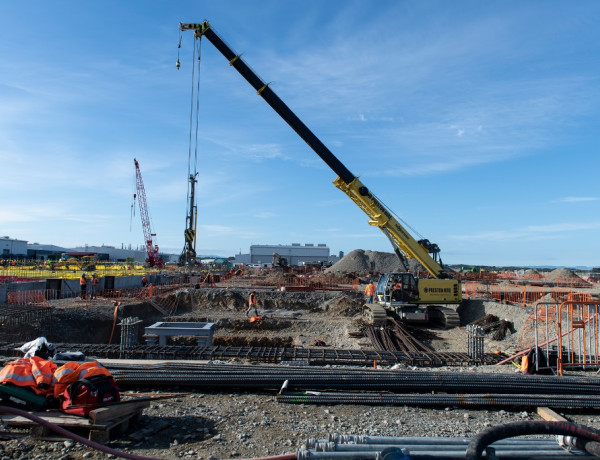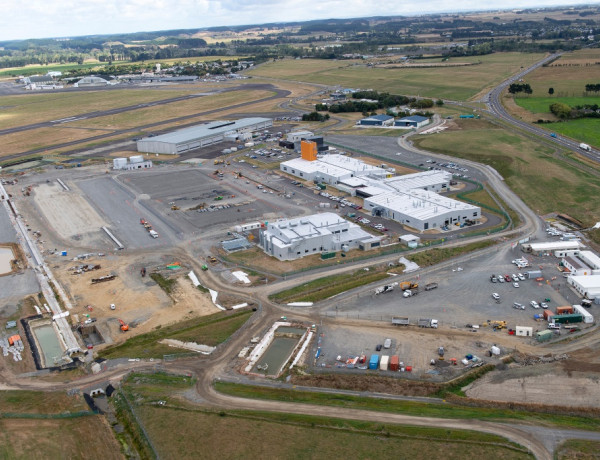The foundations have been laid and piles drilled 20 metres deep, as work on the largest and most complex construction project undertaken by the Ministry of Defence and New Zealand Defence Force gathers momentum.
When complete, the new facility being built at Base Ōhakea will be home to No. 5 Squadron and their four new Royal New Zealand Air Force P-8A Poseidon aircraft.
Due to the size and complexity of the project, the defence agencies have set up an integrated project team, which is made up of both Ministry of Defence staff and New Zealand Defence Force (NZDF) personnel. Project Lead, Rob Whight, says the first P-8A Poseidon is scheduled to touch down in the Manawatū-Whanganui region early 2023.
“It’s a huge project, with many layers of complexity. The team is working with Boeing to build an aircraft that is fit-for-purpose for the Royal New Zealand Air Force. It’s also working with Air Force personnel to manage the largest defence construction project ever undertaken, and install a state of the art flight simulator and maintenance simulator”, said Rob Whight.
When the facility is finished, it will be 180 metres long, with two large aircraft hangars. There will also be a large administration and training block, alongside mission support facilities.
With the piling work complete, Project Infrastructure Director, Robin Scott, says the next stage in the project is to erect the vertical structure.
“The roof over top of each hangar will be 25 metres high, or about seven stories up. Locals will have noticed we’ve got two huge cranes on site that will be used to erect the vertical structure,” said Robin Scott.
The arrival of the Poseidon represents a significant economic boost for the Manawatū-Whanganui region. Hawkins Construction has been awarded the contract to build the facility. Fulton Hogan has finished the site preparation contract, and is completing the apron and taxiway works. At the peak of the $250 million construction project, 500 workers will be on site.
“A huge thank you to all of the teams who are working so hard to make this project a success. We are really excited to be working so closely with our colleagues in the NZDF, as well as the civilian designers and contractors on this project,” said Robin Scott.
The facility under construction has been designed to withstand large seismic events and operate as a post-disaster response centre for Joint Force Headquarters, if ever needed.
Training for No. 5 Squadron, who will operate the aircraft, is well underway. One Kiwi crew is already trained and instructing the crews of other nations in Florida, USA. Wing Commander Mark Whiteside says another team of maintenance personnel are currently stationed in Australia, gaining experience with the Royal Australian Air Force.
“Having this core group of our personnel trained and gaining experience with our partner nations, ahead of the delivery of the P-8A capability, is invaluable and will enable us to hit the ground running. The NZDF and Ministry of Defence are working to grow the pool of skilled and experienced personnel ahead of the arrival of the Poseidons, in order to ensure the most efficient introduction into service,” said Mark Whiteside.
Mark Whiteside says it’s an incredible opportunity to be able to work on the construction of the Ōhakea facility.
“It is such a privilege to be involved in the design and construction of the facility, which will soon house all of the elements of the P-8A capability, including No. 5 Squadron. The Squadron is about to celebrate its 80th anniversary and I believe this will be the first time in its history it has had a facility designed and built specifically for its needs.”
In Wichita County, Texas, Boeing will soon start to assemble the main body of the first New Zealand Poseidon, before it is shipped to Seattle for a tailored fit of mission systems.
The P-8A Poseidon aircraft are replacing the P-3K2 Orions, which have been in use since 1966, and are approaching the end of their operational life.
Like the Orions, the Poseidon aircraft will deliver support to New Zealand’s peace and security operations, maritime surveillance, resource protection, humanitarian and disaster responses, here in New Zealand, the Pacific, and further abroad.
This capability saves lives. In the last decade, more than 200 lives were saved in the wider search and rescue region patrolled by the P-3K2 Orion.
P-8A Poseidon statistics
Wingspan: 123.6 ft (37.64 m)
Length: 129.5 ft (39.47 m)
Height: 42.1 ft (12.83 m)
Propulsion: Two CFM56-7B engines 27,300 lbs thrust
Speed: 490 kts (902km/h)
Range: 1,200 nm with 4 hours on station
Ceiling: 41,000 ft (12,496 m)
Crew: 9
Facility piles: 20 x drilled 20 metres deep
Facility length: 180 metres
Hangar height: 25 metres


